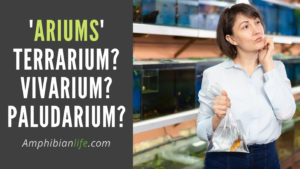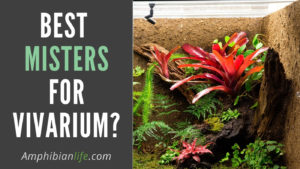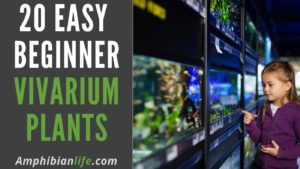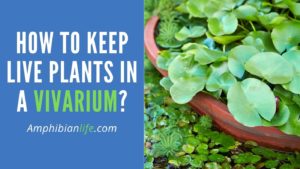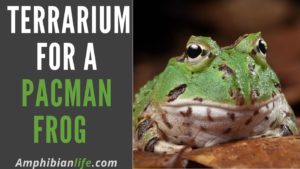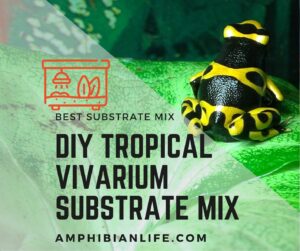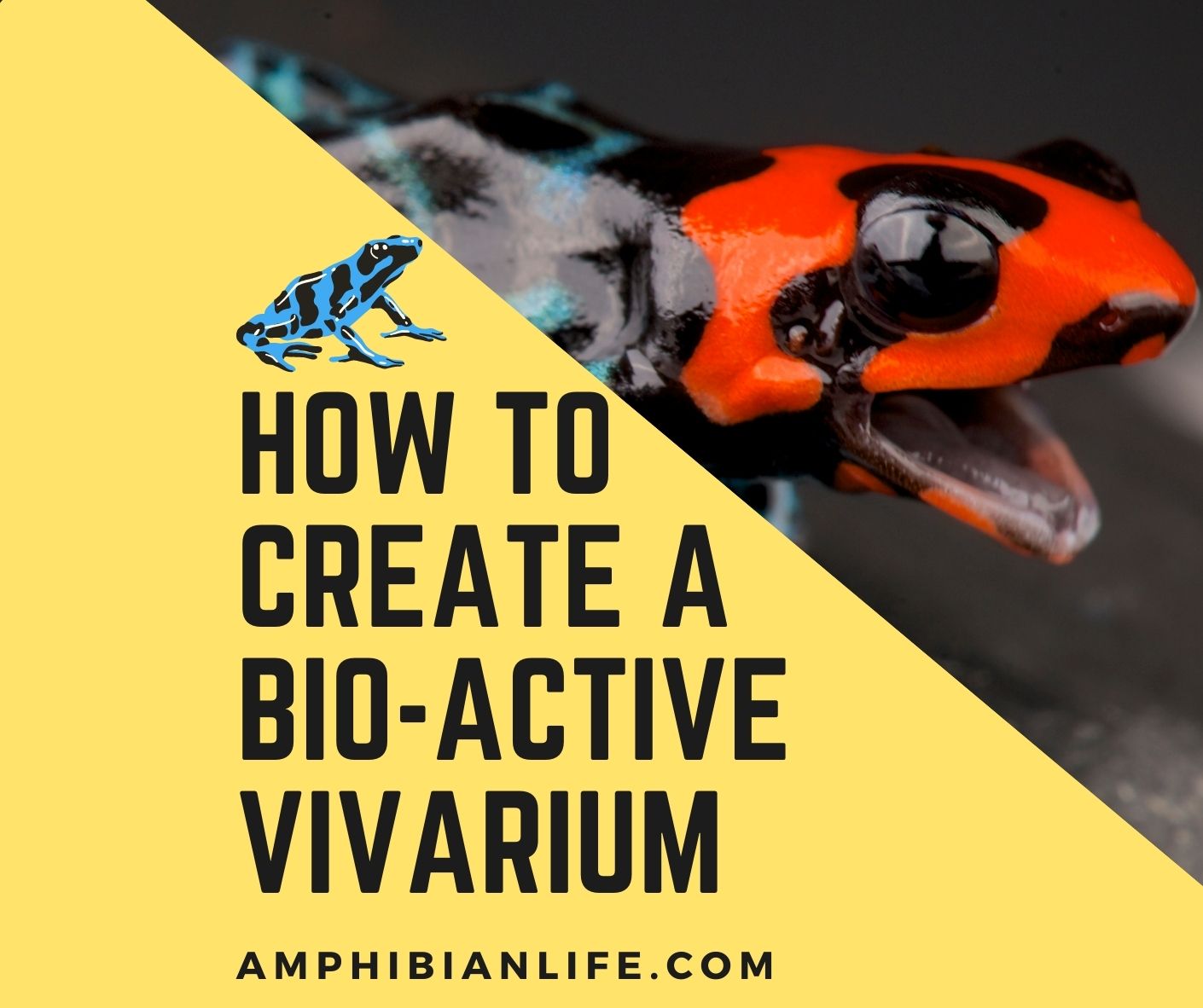
In this article, we will be discussing creating a self-sustaining Bioactive Terrarium for Dart Frogs aka Dendrobatids.
A Semi Self Sustaining Dendrobatid Vivarium
The tank setup described below is the one that I use for my breeding and rearing tanks.
Its primary purpose is to provide the Dendrobates with an environment that is heavily planted,
high in humidity, and uses the plants to filter and clean the water that is constantly available to them.
I have been using this setup and once the Pothos become heavily rooted in the Green moss and water,
then the water that is available for the frogs always looks good (I have not had it tested).
How to create a Arid Bioactive Paludarium terrarium?
I do not believe that I have had any frogs go down because of this type of tank setup and I do not have to change water dishes regularly.
I will strip a tank only when I believe that a diseased frog was in it.
My maintenance involves spraying the tank heavily, and then siphoning out all the old water and adding new water.
If this works for you too then I am glad, if not, then I am open to better suggestions.
Also, my display tanks are all just variations of this theme.
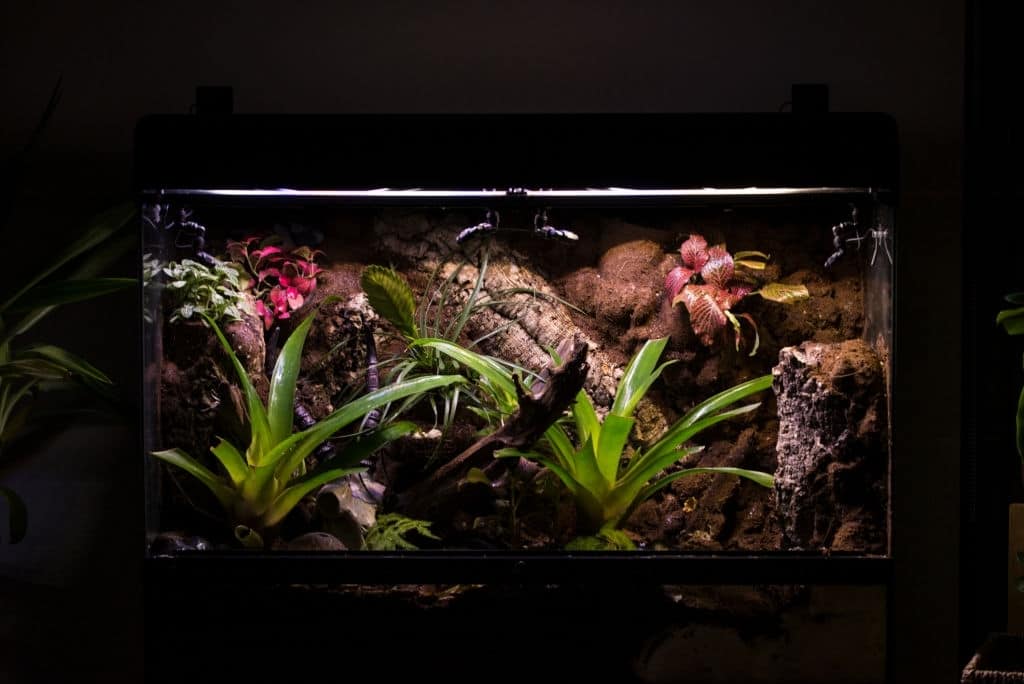
So, How do you make a bioactive terrarium?
Some of the Things you will Need:
- STANDARD 10 GALLON FISH AQUARIUM
- BAG OF ½ INCH PVC SPACERS
- SHEET OF EGG-CRATE LIGHTING PANEL
- SHEET OF LIGHTING PANEL (LITTLE PYRAMIDS)
- BAG OF GREEN MOSS
- 6 INCH POT SIZE OF PATHOS (DEVIL’S IVY)
- QUICK-COUNT 7-MESH CANVAS
- 1 GALLON OF SPRING, or REVERSE OSMOSIS, WATER (NOT PURIFIED)
- 18 INCH FLUORESCENT LIGHTING FIXTURE
Everything listed above can be purchased at a hardware store like Home Depot,
except the 7-mesh canvas which I get at a craft store, and the aquarium of course.
Also note, that there will be leftover materials that can be used on other setups so that each tank will not end up costing cheaper.
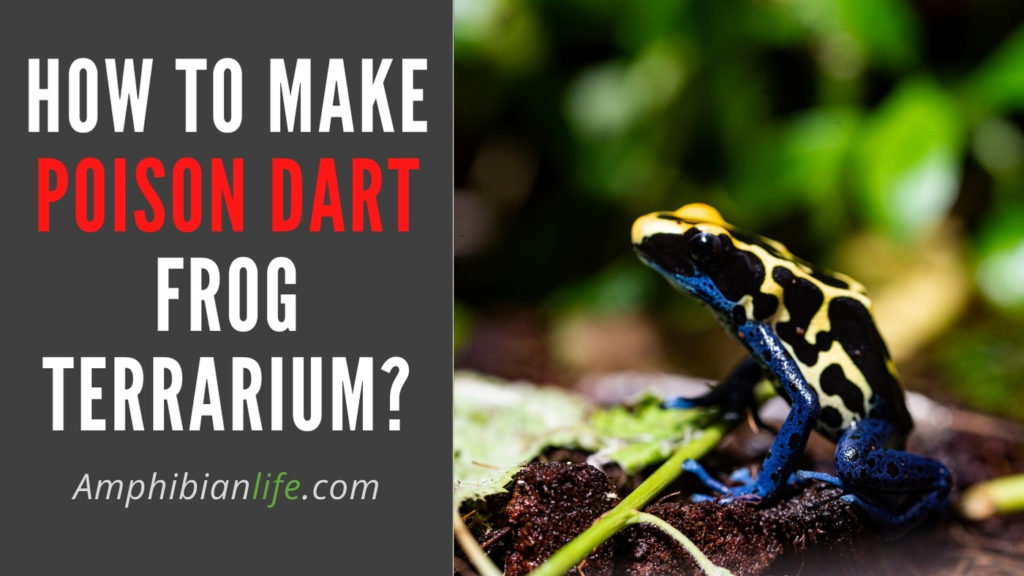
Cleaning the Vivarium
Begin by cleaning the aquarium and the plastics that will go into it.
I have found that it is sufficient to simply rinse them off well, but feel free to use a cleaner or soap.
Just make sure that you rinse everything off well.
Dry the glass of the tanks so you will not get any mineral deposits.
This will be avoided after the tank is set up by the use of the spring or Reverse Osmosis water.
Using a pair of wire cutters, snip a section of the egg-crate panel so that it is the same width as the interior of your tank, and then make it 4 inches shorter.
We will be using this for the area where the frogs will be able to get down to the water.
You can fine-tune the width by trimming the individual tongs from the side that you snipped.
Snip the end for the length you cut close to the next square so you have an even edge.
Place five spacers on end, at the bottom of the empty tank.
They should be oriented in a rectangle with one in the middle.
Now, put the egg-crate on top of the spacers.
What is a false bottom terrarium?
A false bottom is simply a reserved layer of substrate used in the inner base of the vessel being used to create your vivarium.
its importance lies in the fact that it prevents excess water accumulation in roots,
thus preventing them from rotting, and also maintains a healthy environment in the vivarium.
Note: Waterlogged substrate may cause foul-smelling and growth of harmful bacteria in the vivarium ecosystem.
Do bio-active tanks requires a drainage layer?
Usually, a bioactive paludarium is self-sustaining, but in case the tank is fully enclosed with a non-removable bottom layer,
using a simple water pump can easily expel excess water and also recycle the drainage water.
Vivarium Egg Crate Method
The egg-crate should be flush with one end of the tank so you can still see about four inches of the bottom of the tank on the other end.
There is a variation of this that I use for my bigger tanks (40 and 55 gallons);
I cut the egg- crate even shorter (proportionally) and place it in the exact center so that there will be areas of water available to the frogs at both ends.
I have another tank where the water is in the middle and the ends are flush, so you can begin to see the possibilities. Use your imagination.
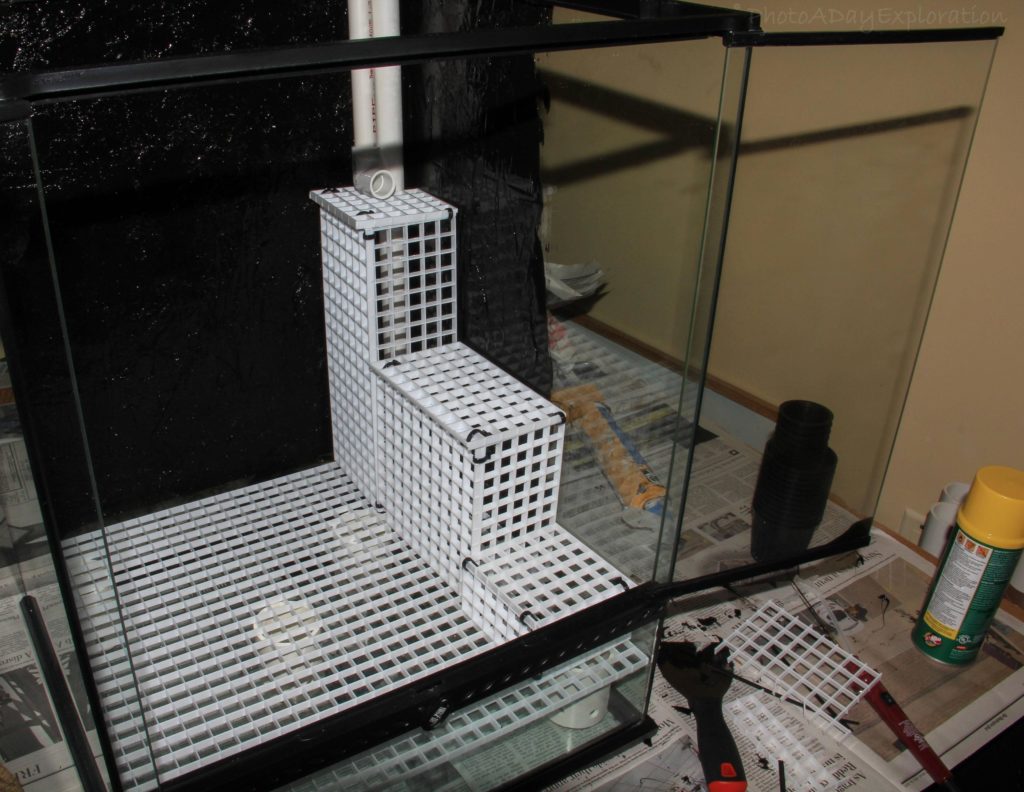
Now, take the 7-mesh and trim its width so that it sits nicely on the egg-crate.
If you bought the small sheets then you will have to trim the length of one, using part of another sheet.
That is OK, but I always hang the longer piece over the end of the tank without the egg-crate (it should reach almost the end of the tank).
This will give it more stability. Notice, that this will keep the frogs from getting under the egg-crate and drowning.
You can now secure the mesh to the egg- crate using wire (I use a small-grade, copper-insulated wire) so that it won’t move around.
Another benefit of doing this will be seen when you break the tank down (the mesh will stay attached to the egg-crate and the Pothos roots will have intertwined with both).
how to ventilate a vivarium?
Put everything back in the tank, and using a sharp knife (I use a steak knife) cut holes in the mesh where you will want to put your Pothos clippings.
I usually space my holes all along the perimeter and pretty heavily between the water and a clear area at the other end of the tank (this is where I place my hut).
How to Choose the Right Tank Size?
One note, I use my 10 gallons for breeding tanks (like the National Aquarium in Baltimore), so I have them on shelves side by side, deep or lengthwise.
I can fit four 10 gallons. aquariums on a 48-inch shelf this way (I only have to use a single 48-inch shop light for 4 tanks then),
So the water end faces outward and the hut end is in the back, giving frogs some privacy.
On the bigger tanks, I don’t cut holes, because I don’t use Pothos cuttings,
I plant African Violets, Ferns, and other plants directly into the Green moss, and their roots work through the mesh to the water.
For Further Reading: Vivarium Plants for Beginners (20 Easy Vivarium Plants)
Take your Pothos plant and collect cuttings from it.
Rinse the cuttings in not-to-cold tap water to remove any pesticide(s)
(the chlorine in the tap water helps sterilize them too).
Place the cuttings in the holes of the mesh.
Soak the green moss in the spring water and then place it on the mesh, working it around your cuttings.
Make sure you pack it fairly tightly so that it is up against the three sides of the tanks and supporting the cuttings.
I don’t put any green moss in the water end, but I suppose you could put a little.
The mesh should be hanging over the end of the egg-crate, touching and covering the bottom of the tank to almost the end of the tank,
and you can now put pebbles and bigger rocks to make a little beach for your frogs.
I will usually just place one river rock to hold the mesh down,
then I don’t have to add as much water to the bottom of the tank, and the frogs seem to prefer this.
How to Water a Terrarium?
Add some more spring water to the tank, but do not fill it to the top of the spacers, you do not want the green moss sitting on the water.
I usually only have about a ¼ inch of standing water when I first set up a tank, so that I can mist or spray it down a good many times before I have to siphon some off.
For the lid, measure the width and length on the inside lip of the top of your tank, and using marker trace lines on the smooth side of the panel.
Using a utility knife score the panel, and then snap off the piece.
Test it to make sure that it fits snugly on the top lip of your tank.
You can leave it as one piece, in which case you should drill some air holes in the middle,
or I cut that piece in the middle so that I only have to lift one end to feed, and the gap is big enough so that I don’t have to make any air holes.
Is a bioactive terrarium worth it?
Yes, a bioactive terrarium is definitely worth the price and setup.
A properly functioning bioactive enclosure provides a perfectly healthy environment for pets.
Moreover, Once properly established, the habitats are not only good-looking,
But also easy to care for and provides a natural wild-like environment for your pets even in captivity.
And there we go: Conclusion
I live in Arizona where the average humidity is about 20%,
so using this type of lid I can create an environment with about 80% humidity,
which is perfect for the average Dendrobate.
I suppose you could use a screen top if you lived in a high humidity area.
At one end of the panel drill two holes about ¾ of an inch apart and use some more wire to make a little handle (I have used plastic ties in a pinch).
Put the lid(s) on the tank and place your light fixture on top and you are done with the necessities, from here out it is up to you to customize.
Good Luck Amigos!!
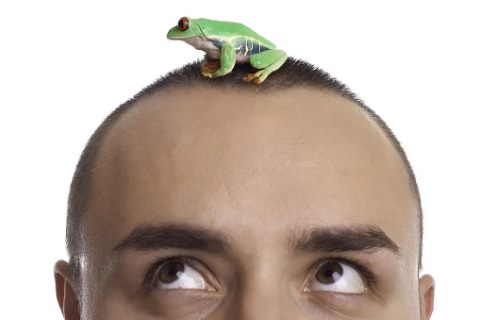
Hi, I’m Mike, and I’m the creator of amphibianlife.com. If there was one word to describe it? It would be: passionate about Amphibians! Whether you want to know more about amphibians or have a presentation to give at school, you’ve come to the right place.

